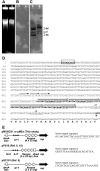Construction and characterization of shuttle vectors for succinic acid-producing rumen bacteria
- PMID: 17616626
- PMCID: PMC2042079
- DOI: 10.1128/AEM.01382-07
Construction and characterization of shuttle vectors for succinic acid-producing rumen bacteria
Abstract
Shuttle vectors carrying the origins of replication that function in Escherichia coli and two capnophilic rumen bacteria, Mannheimia succiniciproducens and Actinobacillus succinogenes, were constructed. These vectors were found to be present at ca. 10 copies per cell. They were found to be stably maintained in rumen bacteria during the serial subcultures in the absence of antibiotic pressure for 216 generations. By optimizing the electroporation condition, the transformation efficiencies of 3.0 x 10(6) and 7.1 x 10(6) transformants/mug DNA were obtained with M. succiniciproducens and A. succinogenes, respectively. A 1.7-kb minimal replicon was identified that consists of the rep gene, four iterons, A+T-rich regions, and a dnaA box. It was found that the shuttle vector replicates via the theta mode, which was confirmed by sequence analysis and Southern hybridization. These shuttle vectors were found to be suitable as expression vectors as the homologous fumC gene encoding fumarase and the heterologous genes encoding green fluorescence protein and red fluorescence protein could be expressed successfully. Thus, the shuttle vectors developed in this study should be useful for genetic and metabolic engineering of succinic acid-producing rumen bacteria.
Figures





Similar articles
-
Construction of a shuttle vector for the overexpression of recombinant proteins in Actinobacillus succinogenes.Plasmid. 2004 Mar;51(2):108-15. doi: 10.1016/j.plasmid.2003.11.003. Plasmid. 2004. PMID: 15003707
-
Sequence analysis of two cryptic plasmids from Bifidobacterium longum DJO10A and construction of a shuttle cloning vector.Appl Environ Microbiol. 2006 Jan;72(1):527-35. doi: 10.1128/AEM.72.1.527-535.2006. Appl Environ Microbiol. 2006. PMID: 16391088 Free PMC article.
-
From genome sequence to integrated bioprocess for succinic acid production by Mannheimia succiniciproducens.Appl Microbiol Biotechnol. 2008 May;79(1):11-22. doi: 10.1007/s00253-008-1424-3. Epub 2008 Mar 14. Appl Microbiol Biotechnol. 2008. PMID: 18340442 Review.
-
Cloning of erythromycin-resistance determinants and replication origins from indigenous plasmids of Lactobacillus reuteri for potential use in construction of cloning vectors.Plasmid. 1999 Jul;42(1):31-41. doi: 10.1006/plas.1999.1402. Plasmid. 1999. PMID: 10413663
-
Development of shuttle vectors for spirochetes.J Mol Microbiol Biotechnol. 2000 Oct;2(4):443-5. J Mol Microbiol Biotechnol. 2000. PMID: 11075916 Review.
Cited by
-
Mannheimia succiniciproducens phosphotransferase system for sucrose utilization.Appl Environ Microbiol. 2010 Mar;76(5):1699-703. doi: 10.1128/AEM.02468-09. Epub 2010 Jan 15. Appl Environ Microbiol. 2010. PMID: 20081002 Free PMC article.
-
One step forward, two steps back: Transcriptional advancements and fermentation phenomena in Actinobacillus succinogenes 130Z.PLoS One. 2021 May 3;16(5):e0245407. doi: 10.1371/journal.pone.0245407. eCollection 2021. PLoS One. 2021. PMID: 33939701 Free PMC article.
-
The CpxRA two-component system is involved in the maintenance of the integrity of the cell envelope in the rumen bacterium Mannheimia succiniciproducens.Curr Microbiol. 2015 Jan;70(1):103-9. doi: 10.1007/s00284-014-0686-5. Epub 2014 Sep 18. Curr Microbiol. 2015. PMID: 25231942
-
Distinct roles of β-galactosidase paralogues of the rumen bacterium Mannheimia succiniciproducens.J Bacteriol. 2012 Jan;194(2):426-36. doi: 10.1128/JB.05911-11. Epub 2011 Nov 11. J Bacteriol. 2012. PMID: 22081396 Free PMC article.
-
Membrane engineering via trans-unsaturated fatty acids production improves succinic acid production in Mannheimia succiniciproducens.J Ind Microbiol Biotechnol. 2018 Jul;45(7):555-566. doi: 10.1007/s10295-018-2016-6. Epub 2018 Jan 29. J Ind Microbiol Biotechnol. 2018. PMID: 29380151
References
-
- Bradford, M. M. 1976. A rapid and sensitive method for the quantitation of microgram quantities of protein utilizing the principle of protein-dye binding. Anal. Biochem. 72:248-254. - PubMed
-
- Cohen, S., M. Couturier, G. del Solar, R. Díaz-Orejas, M. Espinosa, R. Giraldo, L. Jánniere, C. Miller, C. M. Osborn, and C. M. Thomas. 2000. Plasmid replication and copy number control, p. 1-47. In C. M. Thomas (ed.), The horizontal gene pool: bacterial plasmids and gene spread. Harwood Academic Publishers, Amsterdam, The Netherlands.
-
- Giraldo, R., and M. E. Fernández-Tresguerres. 2004. Twenty years of the pPS10 replicon: insights on the molecular mechanism for the activation of DNA replication in iteron-containing bacterial plasmids. Plasmid 52:69-83. - PubMed
-
- Guettler, M. V., D. Rumler, and M. K. Jain. 1999. Actinobacillus succinogenes sp. nov., a novel succinic-acid-producing strain from the bovine rumen. Int. J. Syst. Bacteriol. 49:207-216. - PubMed
Publication types
MeSH terms
Substances
LinkOut - more resources
Full Text Sources
Other Literature Sources
Molecular Biology Databases

